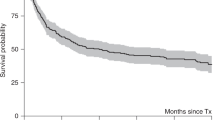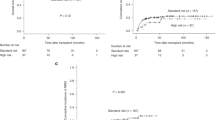Abstract
The role of autologous peripheral blood progenitor cell (PBPC) transplantation for high-risk stage II/III breast cancer remains controversial. New prognostic indicators defining subsets of patients who may benefit from autologous PBPC transplantation would be clinically useful. The axillary lymph node ratio, defined by the total number of axillary nodes involved with cancer divided by the number of axillary nodes surgically sampled, has been reported to be of potential prognostic importance in transplantation for high-risk, stage II/III breast cancer. We therefore retrospectively reviewed 111 women with high-risk, stage II/III breast cancer with at least four positive axillary lymph nodes undergoing autologous PBPC transplantation from 1991 to June 1999. None of the patients had received prior radiotherapy and all had completed one, and only one, course of at least three cycles of adjuvant chemotherapy. The median number of axillary nodes sampled was 20 (range 6–40) and the median number of positive axillary nodes was 12 (range 4–35). The median node ratio, dividing the number of positive nodes by the number of sampled nodes, was 0.68. Event-free survival was strongly influenced by node ratio. Patients having a node ratio of <0.7 had a 5-year event-free survival of 68%, vs those with a node ratio of ⩾0.7 with a 5-year event-free survival of 46% (P = 0.03). Forty percent of patients with a high node ratio have relapsed vs 20% with a low node ratio (P = 0.02). Multivariate analysis revealed that positive estrogen receptor status and a node ratio of <0.7 were independent factors related to better event-free survival (P = 0.0001 and P = 0.004, respectively). We conclude that patients having a node ratio of <0.7 have a significantly better prognosis following autologous PBPC transplantation than do patients with a ratio ⩾0.7. Bone Marrow Transplantation (2001) 27, 843–846.
This is a preview of subscription content, access via your institution
Access options
Subscribe to this journal
Receive 12 print issues and online access
$259.00 per year
only $21.58 per issue
Buy this article
- Purchase on Springer Link
- Instant access to full article PDF
Prices may be subject to local taxes which are calculated during checkout

Similar content being viewed by others
References
Carter C, Allen C, Henson D . Relation of tumor size, lymph node status and survival in 24 740 breast cancer cases Cancer 1989 63: 181–187
Fisher B, Bauer M, Wickerham L et al. Relation of number of positive axillary nodes to the prognosis of patients with primary breast cancer Cancer 1983 52: 1551–1557
Nemoto T, Vana J, Bedwani R et al. Management and survival of female breast cancer Cancer 1980 45: 2917–2924
McGuire W . Prognostic factors in primary breast cancer Cancer Surv 1986 5: 527–536
Somlo G, Doroshow J, Forman S et al. High dose chemotherapy and stem cell rescue in the treatment of high-risk breast cancer: prognostic indicators of progression-free and overall survival J Clin Oncol 1997 15: 2882–2893
Peters W, Ross M, Vredenburgh J et al. High-dose chemotherapy and autologous bone marrow support as consolidation after standard-dose adjuvant therapy for high-risk primary breast cancer J Clin Oncol 1993 11: 1132–1143
Gianni AM, Siena S, Bregni M et al. Efficacy, toxicity, and applicability of high-dose sequential chemotherapy as adjuvant treatment in operable breast cancer with 10 or more involved axillary nodes: five-year results J Clin Oncol 1997 15: 2312–2321
Holland HK, Dix S, Geller R et al. Minimal toxicity and mortality in high-risk breast cancer patients receiving high-dose cyclophosphamide, thiotepa, and carboplatin plus autologous marrow/stem-call transplantation and comprehensive supportive care J Clin Oncol 1996 14: 1156–1164
Antman K, Rowlings P, Vaughan W et al. High-dose chemotherapy with autologous hematopoietic stem-cell support for breast cancer in North America J Clin Oncol 1997 15: 1870–1879
Bearman S, Overmoyer B, Bolwell B et al. High-dose chemotherapy with autologous peripheral blood progenitor cell support for primary breast cancer in patients with 4–9 involved axillary lymph nodes Bone Marrow Transplant 1997 20: 931–937
Peters W, Rosner G, Vredenburgh J et al. A prospective, randomized comparison of two-doses of combination alkylating agents (AA) as consolidation after CAF in high-risk primary breast cancer involving ten or more axillary lymph nodes (LN): preliminary results of CALGB 9082/SWOG 9114/NCIC MA-13 ASCO 35th Ann Meet 1999 18: 1a
The Scandinavian Breast Cancer Study Group 9401 . Results from a randomized adjuvant breast cancer study with high-dose chemotherapy with CTCb supported by autologous bone marrow stem cells versus dose escalated and tailored FEC therapy ASCO 35th Ann Meet 1999 18: 2a
Nieto Y, Cagnoni P, Shpall E et al. A predictive model for relapse in high-risk primary breast cancer patients treated with high-dose chemotherapy and autologous stem cell transplant Clin Cancer Res 1999 5: 3425–3431
Fisher B, Slack N, Bross I et al. Cancer of the breast: size of neoplasm and prognosis Cancer 1969 24: 1071–1080
Ferguson D, Meier P, Karrison T et al. Staging of breast cancer and survival rates JAMA 1982 248: 1337–1341
Fisher B, Redmond C, Fisher E et al. Relative worth of estrogen or progesterone receptor and pathologic characteristics of differentiation as indicators of prognosis in node negative breast cancer patients: findings from national surgical adjuvant breast and bowel project protocol B-06 J Clin Oncol 1988 6: 1076–1087
Koscielny S, Tubiana M, Le MG et al. Breast cancer: relationship between the size of the primary tumor and the probability of metastatic dissemination Br J Cancer 1984 49: 709–715
Andrulis I, Bull S, Blackstein ME et al. neu/erB-2 amplification identifies a poor prognosis group of women with node-negative breast cancer J Clin Oncol 1998 16: 1340–1349
Hryniuk W, Bush H . The importance of dose intensity in chemotherapy of metastatic breast cancer J Clin Oncol 1984 2: 1281–1288
Wood W, Budman D, Korzun A et al. Dose and dose intensity of adjuvant chemotherapy for stage II, node-positive breast carcinoma New Engl J Med 1994 330: 1253–1259
Tannock I, Boyd N, DeBoer G et al. A randomized trial of two dose levels of cyclophosphamide, methotrexate, and fluorouracil chemotherapy for patients with metastatic breast cancer J Clin Oncol 1988 6: 1377–1387
Author information
Authors and Affiliations
Rights and permissions
About this article
Cite this article
Bolwell, B., Andresen, S., Pohlman, B. et al. Prognostic importance of the axillary lymph node ratio in autologous transplantation for high-risk stage II/III breast cancer. Bone Marrow Transplant 27, 843–846 (2001). https://doi.org/10.1038/sj.bmt.1703004
Received:
Accepted:
Published:
Issue Date:
DOI: https://doi.org/10.1038/sj.bmt.1703004
Keywords
This article is cited by
-
Ratios of involved nodes in early breast cancer
Breast Cancer Research (2004)



